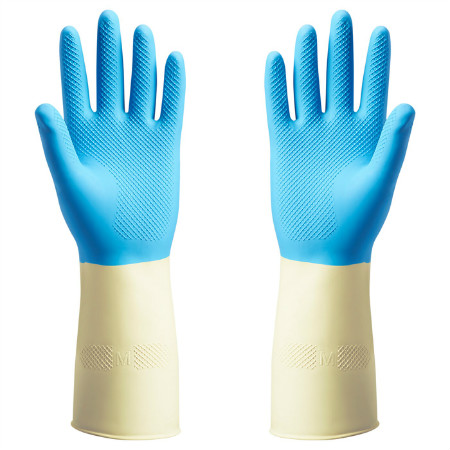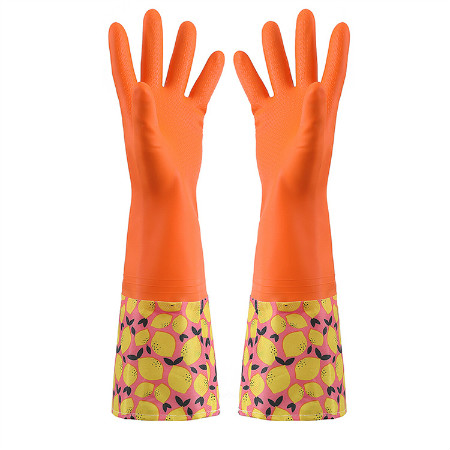The difference between latex gloves and nitrile gloves!
1. Material difference
Latex gloves are also called rubber gloves. Latex is a natural material derived from rubber tree sap. Natural latex is a biosynthetic product. Due to different tree species, geology, climate and other related conditions, its composition and structure will often vary greatly. In the fresh latex without any substance, the rubber hydrocarbon only accounts for 20%-40% of the total, and the remaining small amount is non-rubber components and water. Non-rubber components include proteins, lipids, sugars, and inorganic components. Some of them form a composite structure with rubber particles, and some are dissolved in whey or form non-rubber particles.
Nitrile is a kind of rubber, mainly synthesized from acrylonitrile and butadiene, and is a key material for organic synthesis and pharmaceutical intermediates.

2. Classification difference
Latex gloves are divided into powder-normal type and powder-free purification type, with smooth and pitted surface slip resistance.
The nitrile glove model is divided into non-slip palm numb surface and hand tip numb surface non-slip, overall numb surface non-slip, generally no powder.

3. Anti-allergic
Latex gloves contain protein, and people who are prone to allergies are prone to allergic reactions.
Nitrile gloves do not contain protein, amino compounds and other harmful substances, and rarely cause allergies.
4. Degradability
Latex gloves and nitrile gloves are both degradable, easy to handle, and environmentally friendly.
5. Puncture resistance
The toughness and abrasion resistance of latex gloves are slightly inferior to those of nitrile gloves.
The puncture resistance of nitrile gloves is three to five times higher than latex. For dentists who need to use sharp tools, using durable nitrile gloves can create a safer barrier in contact with patients.
6, flexibility
Latex gloves are soft and wear-resistant, and have better elasticity than nitrile gloves.
7. Fit the hand shape
Because the nitrile glove contains butadiene monomer, it can be a flexible rubber, which allows the wearer to experience the best tactile sensitivity. In addition, the fit hand shape is due to its good thermal conductivity, which provides excellent flexibility, which is particularly important for medical professionals or those who operate small parts or tools.
8. Price
Because the nitrile material is much better than latex in chemical resistance, acid and alkali resistance, the price of nitrile gloves is higher than latex products.
9. Color
The nitrile material can be added with pigments and the color is brighter. Can relieve the nervousness of patients.
In addition, nitrile gloves have certain antistatic properties because of their non-silicon content, low surface chemical residues, low ion content, and small particle content. They are suitable for strict clean room environments.
In summary, gloves are not absolutely good or bad. People can choose the gloves that suit them according to their needs when using them.
The material of nitrile gloves is degradable, and it is not allergic to wear. It can be added with pigments and the color is brighter. Its disadvantage is that it has poor elasticity and is more expensive than latex gloves;
PVC gloves are made of polyvinyl chloride. The advantage of PVC gloves is that they are low in price and can be added with pigments to create bright colors. The disadvantage is that they contain higher plasticizers. Plasticizers are internationally recognized as the public enemy of health. They are easily volatile when heated. Moreover, it is not degradable; the advantage of latex gloves is that they are degradable and elastic. However, long-term wear of latex gloves can cause skin allergies.
So their anti-static performance? ESD refers to the anti-static performance of the product. It is generally believed that nitrile rubber products have anti-static properties, while PVC and latex do not have anti-static properties, and are not suitable for ESD areas.
In fact, the antistatic properties of nitrile gloves and nitrile gloves also depend on the formula of glue. The ESD performance of products made by different manufacturers' glues is different, and it has little relationship with the glove manufacturer, even made of the same glue. There will also be differences in product performance, so Nitrile and Nitrile gloves can be used as general anti-static gloves, but their performance is lower than that of professional anti-static gloves.

Pay attention to when wearing Nitrile gloves:
1. No rings or other jewelry on your hands;
2. The fingernails should be trimmed regularly and not too long to avoid damage to the fingertips of the gloves;
3. Prevent the piercing of sharp objects, such as needles, toothpicks, etc.;
4. Taking off the gloves is to slowly withdraw from the wrist downwards, and cannot pull from the finger;
5. Pay attention to the size when choosing, too small will cause the blood to flow and unsmooth, and too large will easily fall off;
6. Periodic inspections are required. If damaged, it cannot be used again.
Precautions for using PVC gloves
1. Disposable PVC gloves do not have high temperature resistance and insulation properties. It must not be used in high-temperature workplaces, and it is never allowed to be used as insulating gloves.
2. Once the product is cut using disposable PVC gloves, it will affect the protective effect. Please do not use it.
3. Disposable PVC gloves should be kept ventilated and dry when stored to prevent moisture and mold.
4. When using disposable PVC gloves. Prohibit contact with corrosive substances.
Precautions for latex gloves are as follows:
1. Avoid contact with chemicals such as acids, alkalis, and organic solvents.
2. When handling infectious substances, powder-free and low-protein latex gloves should be selected. Powder-free and low-protein latex gloves can reduce the risk of allergies. However, the so-called hypoallergenic latex gloves cannot reduce the risk of latex allergy, but can only reduce the allergic reactions caused by chemical additives in latex gloves.
3. Resolutely implement the work rules to reduce the chance of latex harm. Such as:
1) Do not use oily hand cream or lotion when wearing latex gloves, as it will cause deterioration or damage to latex gloves.
2) After taking off or removing latex gloves, wash your hands with mild soap and dry your hands completely.
3) Disposable latex gloves cannot be worn repeatedly (because the gloves may have lost the ability to defend against harmful substances).
